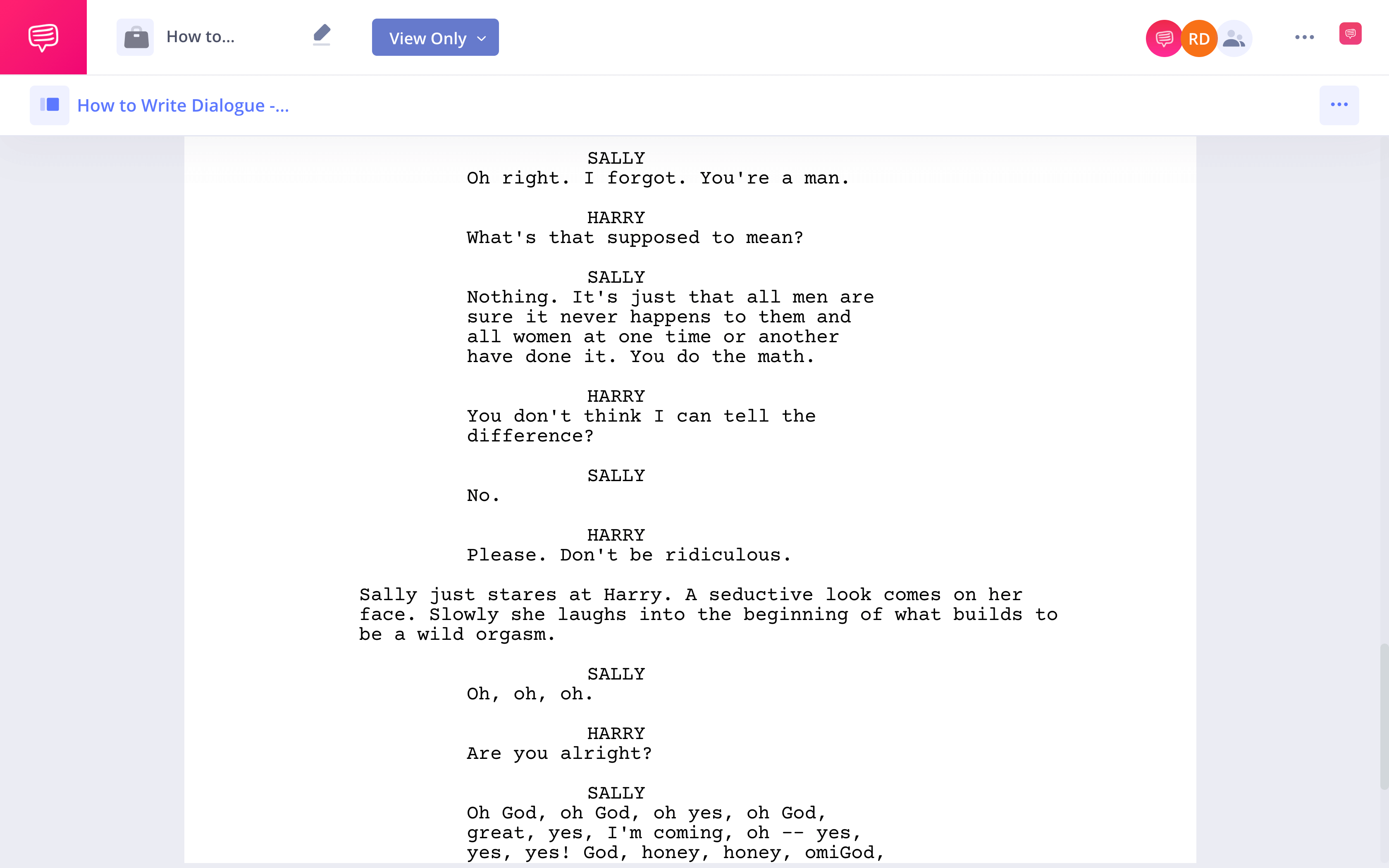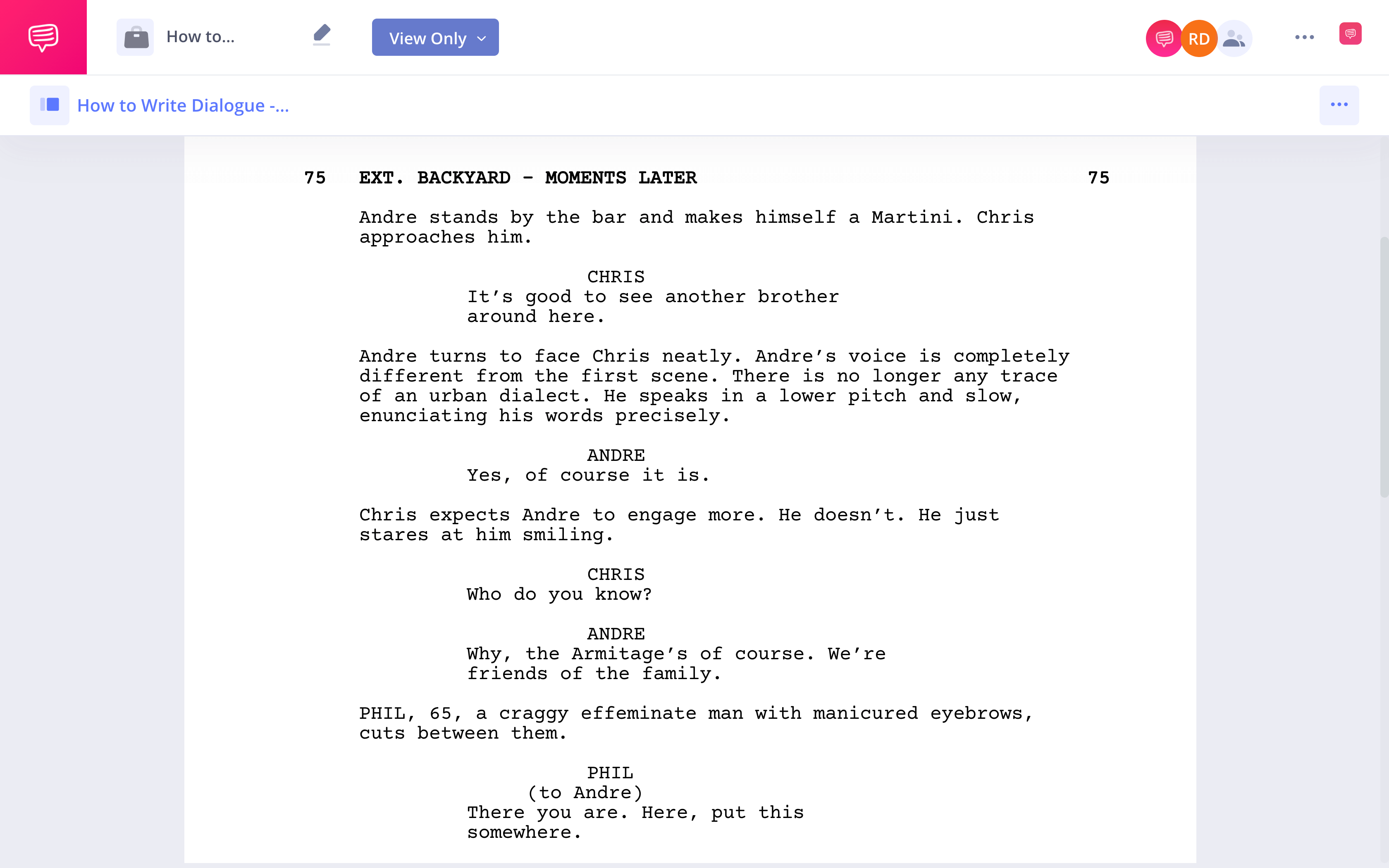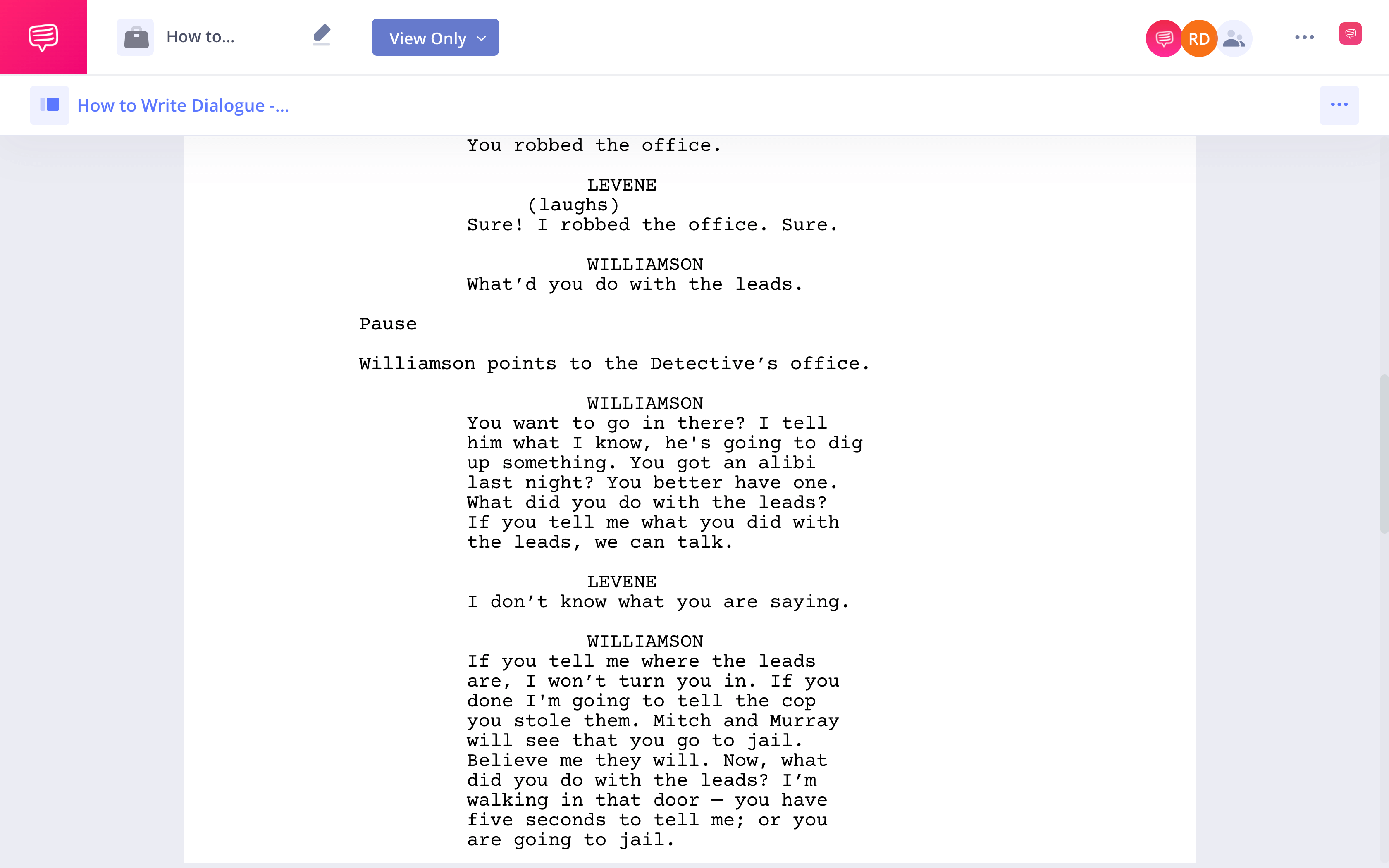Every storyteller — whether a screenwriter, novelist, or short story writer — wants to write dialogue that snaps, reveals character, and carries emotional weight. But how do you do it? There are countless lists and guides filled with advice on how to write dialogue in a story or a dialogue script for the screen. In this post, we’ll look at dialogue writing examples across different media, examine some tried-and-true methods for writing effective dialogue, and give you practical tools whether you’re working on a screenplay or a novel.
How to Write Dialogue Format
1. Study dialogue writing
A good first step is to look at accomplished writers to see how they became skilled at how to write dialogue. But we have to know what we’re looking for. You can start by reading dialogue examples from different media or practice with some dialogue prompts to better understand how to write dialogue that flows naturally and serves the story.
Novelists like Jane Austen, Toni Morrison, and Elmore Leonard are revered for dialogue that rings true to the ear and cuts to the emotional core. Austen’s polite but loaded exchanges, Morrison’s lyrical interiority, and Leonard’s punchy, street-smart rhythms each show how varied great dialogue can be in prose. Fiction writers don’t format in script dialogue, but they rely on the same fundamentals — character intention, rhythm, subtext, and escalation.
Writer-director Quentin Tarantino is as famous for his dialogue as he is for breaking the rules of screenwriting. Sure, to be able to craft dialogue that is so compelling it becomes a set piece unto itself, a la Tarantino, may be a good aesthetic model.
But trying to emulate his more stream-of-consciousness approach to dialogue writing may prove disorienting. Check out our video below and see if you notice anything that stands out about his approach to writing dialogue.
Tarantino Dialogue • Subscribe on YouTube
Though Tarantino doesn’t necessarily write according to plotted-out script templates, and he probably doesn't adhere to proper dialogue format all the time. His creative choices might be largely unconscious, and his secret weapon in how to write a good dialogue may be his well-developed characters.
He knows his character types and what they want, and the characters’ desires shape his dialogue writing.
And as we will see when we look at other screenwriters’ methods, character is everything in how to write dialogue in a script.
What is dialogue? • Tarantino on set
As the old adage goes, learning the rules in order to break them can make you a stronger writer – and in this case, we want to look at some of the best writing dialogue rules.
Writing from a structure can help make sure you don’t lose the thread of your story by getting too caught up in crafting clever, flashy dialogue that doesn’t connect to anything.
And, about how good story structure can provide the perimeters for your writing to flow within, so you don’t have to pause to remember fifteen different rules of how to do dialogue!
How to Format Dialogue – Essentials:
- Indent 1.5” from the left margin for speaker names.
- Keep lines short — aim for 1-3 lines max.
- Use (parentheticals) sparingly to guide delivery.
- Use all-caps for character names before their lines.
- Trim fat: Dialogue should reflect urgency, subtext, and rhythm, not casual conversation.
How to Write a Good Dialogue
2. Make your character's wants clear
In a post about how to approach how to write dialogue, it may seem contradictory to say this, but a good rule for dialogue writing in a scene is to write the dialogue last.
After building out the other elements of your story (your character arcs, acts, scenes, and story beats), you will have a better sense of how each scene connects to the larger unfolding of the story and, most importantly, what each character wants in a given scene.
Learning how to format dialogue becomes second nature when you understand what your characters want and the overall structure of the scene. You may not need a “how to write good dialogue format” if you always keep in mind your larger story arc, how each scene drives the story forward, and what character motivations are in every scene.
How to write dialogue • The Social Network
A good starting place in thinking about how to write dialogue in a script is to remember that in a screenplay, dialogue is not mere conversation. So, what does dialogue mean in a well-structured scene? It’s a literary device — every line should move the story forward, reveal something new, or deepen the conflict. It always serves a larger purpose, which is to move the story forward, a vital point when learning how to write dialogue with impact.
The function of dialogue can be broken down into three purposes: exposition, characterization, and action. If we’re always clear on the larger purpose of a scene and we know each character’s motivations, we know what our dialogue is “doing” in that scene.
When we know what a character wants, we don’t have to worry as much about how to write dialogue because the motivations of the characters drive what they say. See our post on story beats to dig into story beats, which help illuminate what each character wants, and when they want it.
Functions of Dialogue
Exposition (to relay important information to other characters)
Characterization (to flesh out who a character is and what they want)
Action (to make decisions, reveal what they’re going to do)
The famous diner scene from Nora Ephron’s When Harry Met Sally is an excellent example of exposition and characterization. These are critical components of how to write dialogue between two characters. Here's a breakdown we did of the iconic When Harry Met Sally screenplay.
The ongoing question of the film, and Harry and Sally’s relationship, is whether heterosexual women and heterosexual men can be platonic friends. Every other character in the film and their issues (the friend in an affair with a married man, the friends who are a happy couple, and getting married) all support the driving dilemma of the film: the desire to partner and escape the presumed suffering of dating.
Take a look at the scene:
What is dialogue? • When Harry Met Sally
Underneath this question of whether men and women can be friends is the subtext that they may ultimately end up together after all. The overriding question of the film is, after knowing each other, “how come they haven’t already?” The diner scene teases out the idea of sexual tension in a supposedly platonic friendship, raising the stakes.
Another tip for how to properly write dialogue is to scan your script for “dialogue dumps.” The best way to avoid “As you know, Bob…” information dumps in your dialogue is to let the characters bat pieces of information back and forth. If a thought feels forced, it might work better broken into a separate sentence. Check out our video on exposition below:
How to write good exposition • Subscribe on YouTube
Let them reveal bits of it over time, scattered throughout a scene like breadcrumbs — each piece of dialogue hinting at something deeper. Let them argue about it, challenge what each other knows, and show how each character speaks from a different emotional perspective or agenda. Do they already know it, or are they wrestling with it?
Assess your dialogue to make sure what you’re trying to accomplish with a line of dialogue couldn’t better be said with an action, an adjustment to scene or setting, a facial expression, or some other nonverbal detail. When quoting within dialogue, use single quotes only when necessary.
Want to make your scenes feel real, layered, and emotionally charged—without spelling everything out? This video breaks down subtext — one of the most powerful tools in a screenwriter’s toolkit.
The Art of Subtext • Subscribe on YouTube
Remember, though the scene depicts Harry and Sally having a conversation in a diner, the words they are speaking are not mere “conversation” – it is dialogue written to sound like a natural conversation. There is a difference.
Each word in Ephron’s dialogue writing has a purpose. Sally says she is upset about how Harry treats the women he dates and that she’s glad she never dated him (underscoring the ongoing conflict of the film).
Harry defends himself, saying he doesn’t hear any of them complaining (alluding to how he wouldn’t disappoint her, either). When Sally suggests the women he dates might be faking orgasm, Harry doesn’t believe her.
This prompts her to fake an orgasm right there in the diner to make her point (ratcheting up the primary conflict, while also providing some comic relief).
You can read the scene, which we imported into StudioBinder’s screenwriting software, below:
What is dialogue? • When Harry Met Sally script
This scene works so well because it serves a crystal clear purpose in driving the story forward.
Great dialogue writing examples always drive the plot from one scene to the next. You may not like plotting out your story beats, thinking about story arcs methodologically, or approaching how to write dialogue between two characters systematically at all.
Dialogue examples from professional screenwriters often follow these rules — and just as often, they break them in deliberate, effective ways. Check out more great dinner scenes to inspire how to tackle this awkward but important type of scene!
How to write dialogue • Subscribe on YouTube
Sometimes, the most powerful things said on screen aren’t said at all. Subtext — the meaning beneath the words — is the true lifeblood of cinematic dialogue.
In The Social Network, Mark Zuckerberg’s cool exterior masks desperation for validation.
Another example, in Get Out, a simple “It’s good to see another brother” carries an iceberg of coded meaning, suspicion, and cultural alienation. These lines hit because the characters don’t say what they mean — they say what the situation requires.
Screenwriting Tip:
If your characters are being too literal, ask: What are they afraid to say? What would it cost them to say the truth out loud?The “Good to See Another Brother” scene from Get Out is a great example of keeping the dialogue minimal and letting facial expression, costume, and tone convey the information:
Get Out screenplay: Chilling dialogue example
At this point in the story, Chris still thinks he is simply one of the few black people in his white girlfriend’s upper-middle-class white family and their social circle.
We, the audience, still might think we’re watching a rom-com that conveys only a mild awareness of race, somewhere off in the background of the story. But in this scene, race starts moving forward as a central plot point.
Chris approaches Andre because he wants to feel a sense of connection in an isolating environment. To convey layers of social anxiety and racial tension, all that Jordan Peele needs is the line, “It’s good to see another brother around here.”
Throughout the film, Peele exemplifies how spreading information out like breadcrumbs can help build tension and curiosity about a scene.
Look at how much room Peele leaves in the script to describe how Andre’s character should convey his response (“soft-spoken,” “no trace of an urban dialect”). This helps load every word in the scene with more weight and purpose. When Andre does speak, his words are few.
He has visibly changed his style and manner of speaking since Chris first saw him. He won’t say much, and has a glazed-over expression on his face. All of this raises the stakes: What is going on here?

What is dialogue? • Get Out
To learn how to write dialogue, one of the most important writing dialogue rules is to stay in touch with where your characters are in the story at all times.
Building your story, your character arcs, and your story beats before writing can help provide a structure that will give your writing a container in which to flow. Developing compelling characters and making sure that every bit of dialogue real estate on the page is devoted to serving a function in your screenplay can help streamline the whole dialogue-writing process.
But regardless of which method you use, if anything, just remember the Mamet Motto: “Nobody says anything unless they want something.”
Related Posts
How to Write Dialogue in a Script
3. Give your dialogue purpose
Finally, we’ve come to our favorite part. The lines. Famed playwright and screenwriter David Mamet says great dialogue boils down to this one concept:
“Nobody says anything unless they want something.”
— David Mamet
This handy motto is one of the best dialogue writing tips, if not the only one you need. This principle encapsulates what many other rules of dialogue writing are getting at. What they want also may not be spoken aloud, which is where writing internal dialogue comes in handy.
The advice to use as few words as possible, to cut the fat, to arrive late and leave early, to write with subtext in mind, to show rather than tell – all of those goals can be met by keeping the focus on what the characters want.

What is dialogue? • David Mamet
If they don’t want anything, they don’t need to say anything. What is dialogue without character motivation? If you have a clear idea of who your characters are and what the function of each scene is in the story, then your characters' agendas, conflicts, and obstacles, and their manner of speaking to express themselves, can come forward more naturally.
If you know what your characters want, you may find that you know how to write dialogue in a story very naturally!
And yet, there is a caveat here: Screenwriter Karl Iglesias warns that it can be easy to have the character say what you, the writer, want, not what they, the character, want.
Below is a playlist from our 4 Endings video series, where we look at how "wants and needs" play out in a screenplay.
Wants vs. Needs • Watch the entire playlist
Because what you, the writer, want them to do is, of course, to carry some part of the story for you. So, another important tool to put in your toolbox of dialogue writing tips is to always zoom in on the character and stay tuned into what they want at any given point in the story.
Check out the last scene from Mamet’s Glengarry Glen Ross, a film based on the screenplay, also by Mamet, and a gold standard of excellent movie dialogue.
Mamet’s principle that each character has to show what they want is demonstrated brilliantly in the final scene. At the beginning of the film, everyone at a New York City real estate office learns that all but the top two salesmen will be fired in two weeks.
Levene (Jack Lemmon) is a salesman who wants to keep his job and survive. In the final scene, Williamson (Kevin Spacey) accuses Levene of stealing leads from the office. By this final scene, what Levene wants has shifted. Now he wants to convince Williamson of his innocence.
Take a look:
How to write dialogue in a movie script • Glengarry Glen Ross
Dialogue Writing Examples
4. Edit and focus the dialogue
Now it’s time to sculpt the general arc of your story into form, and the minimalist principles of how to write dialogue in a story can help bring your vision to life.
You want to cast a harsh light on your text to whittle down everything you’ve written. Make sure every last word is there. You want to yank anything that gets in the way of telling the great story you want to tell. What is dialogue supposed to do if not spark emotion? The best lines feel necessary, not just clever, but loaded with meaning that actors can bring to life.
Remember: Knowing how to format dialogue also means knowing what to cut. Lines that don’t serve a purpose, no matter how clever, slow the momentum and clutter the scene.
Even the cutest remark can be clutter, and even the more mundane lines can play a vital role by elucidating our characters' motives, the conflict they’ve encountered, and where the story is going next. The more dialogue examples you read, the more you’ll see how the characters’ motivations are driving not only what is said, but how it is said.
Writing actor-friendly dialogue
Actors don’t just read lines — they embody them. Great cinematic dialogue doesn’t spell everything out. Instead, it leaves space for performance — room for breath, tension, and unspoken emotion. These are the moments actors live for: when they can express what’s not being said.
Here’s how to give your dialogue more punch on set — and more power in performance:
Write for the breath. Let punctuation shape the rhythm. A well-placed comma, em dash, or period can guide where an actor takes a breath, adding texture and emotion to the delivery.
Use trailing thoughts…Ellipses and fragmented lines suggest hesitation, doubt, or shifting thoughts. They give the actor space to show inner conflict without a single word of exposition.
Build interruption beats. Let characters cut each other off, or leave their sentences unfinished, and avoid using single quotations, which aren’t typically used in screenplay dialogue. It reflects real conversation and adds tension, whether it’s power, discomfort, or chemistry.
Let silence speak. Don’t underestimate the pause, and remember that screenplays don’t use double quotation marks around dialogue the way prose does. A moment of silence between lines can say more than dialogue ever could — longing, loss, realization, regret. Trust the space.
Actors love scripts that invite them to bring life to the lines. These techniques don’t just elevate your dialogue — they transform it into a performance playground.
Dialogue in Novels vs. Screenplays: Key Differences
Screenwriters must craft lines that actors can perform, meaning every word must translate visually and audibly. Novelists, however, write for the reader’s imagination. This grants prose writers more flexibility with pacing, rhythm, and punctuation. Fiction dialogue may unfold over paragraphs, with interior monologue woven between spoken lines. Still, understanding how to write dialogue in a movie script can help even novelists tighten pacing and sharpen stakes in their scenes.
When writing fiction, remember:
Use tags sparingly, but vary them (“she said,” “he muttered,” etc.)
Let setting and action punctuate conversations
Don’t over-explain with adverbs — trust the dialogue and let it stand
Break it up with thoughts or reactions, especially in emotionally complex scenes
Whether you’re writing a play, a novel, or a movie script dialogue scene, the goal remains the same: make it real, make it matter.
How to Write Dialogue That Reveals Character
5. Understanding character voice
Another approach for how to write great dialogue in a script is to read through every line of the script aloud to make sure it flows naturally.
In fiction, this goes hand-in-hand with interiority. While screenwriters rely on visuals and performance, fiction writers have access to internal thoughts and layered narration. A well-crafted exchange in a novel often reads differently than in a script — it can be longer, subtler, or offset with reflection. Still, whether you’re writing a novel or learning how to write dialogue in a movie script, the same principle applies: what does your character want, and what are they not saying?
What does dialogue mean for character development? It’s how you show who’s speaking — not just with words, but with rhythm, tone, and intent. Can you tell who is saying what?
If each character doesn’t have a discernible way of speaking, revisit your character development and define who this person is, what they want, and all their quirks and characteristics. Then revamp their lines to make all of that come to the forefront in each line. And when in doubt, revisit dialogue examples from your favorite movies and shows to get the juices flowing.
Related Posts
Dialogue Workshop
Practice like a pro
Want to sharpen your dialogue? Try this mini-workshop. You can use it with a current script you’re working on or even a brand-new scene idea. It’s a quick, powerful way to inject subtext and make your dialogue feel more dynamic and layered.
Character Objective: What does your character want in this moment? This could be emotional (to be loved), practical (to get a ride), or psychological (to feel superior). Be specific.
Obstacle: What’s stopping them from just saying it outright? Maybe they’re afraid of rejection, trying to maintain power, or simply not fully aware of what they want. This tension is what creates subtext.
Subtext Prompt:
Now rewrite the line three ways:
One where they say exactly what they mean — no filters.
One where they hint at it, indirectly or with a metaphor.
One where they say the opposite — a deflection, denial, or mask.
Run this exercise for each major character in your scene. It forces you to think beyond “what’s said” and into “what’s meant” — and that’s when dialogue starts to crackle with intent.
Final Dialogue Checklist
Don’t skip these 5 questions
No matter how good your dialogue sounds in your head, it needs to earn its place on the page — and screen. It’s not about sounding clever — it’s about character, conflict, and momentum. Use this checklist before finalizing any scene to make sure your dialogue truly serves the story. Use this before locking any scene:
Does each character want something in the scene? Every character should enter the scene with a goal, even if it’s just to hide their feelings or gain approval.
Could this be shown instead of said? Look for lines that might be more powerful as a glance, an action, or a pause.
Does the character have a distinct way of speaking? Make sure their voice is unique, shaped by background, personality, or mood.
Is there subtext under the line? What’s being felt or meant beneath the words? The best dialogue often hides the truth.
Does this dialogue move the story or escalate tension? If it doesn’t push something forward, consider trimming or sharpening it.
If you can’t confidently check all five, take one more pass. The difference between good and great is often just a second look.
UP NEXT
What is internal dialogue?
What makes a character feel real? It’s not just what they say out loud — it’s what they don’t say. Internal dialogue is the heartbeat of character development, revealing their fears, desires, and private truths. Without it, even the sharpest external lines can feel hollow. What does internal dialogue mean in storytelling? It’s how we hear a character think — the voice inside their head that guides their choices and shapes the story’s emotional core. Want to learn how to use it effectively? Check out our next post for tips on how internal dialogue can deepen your characters and give your story the soul it needs.



